
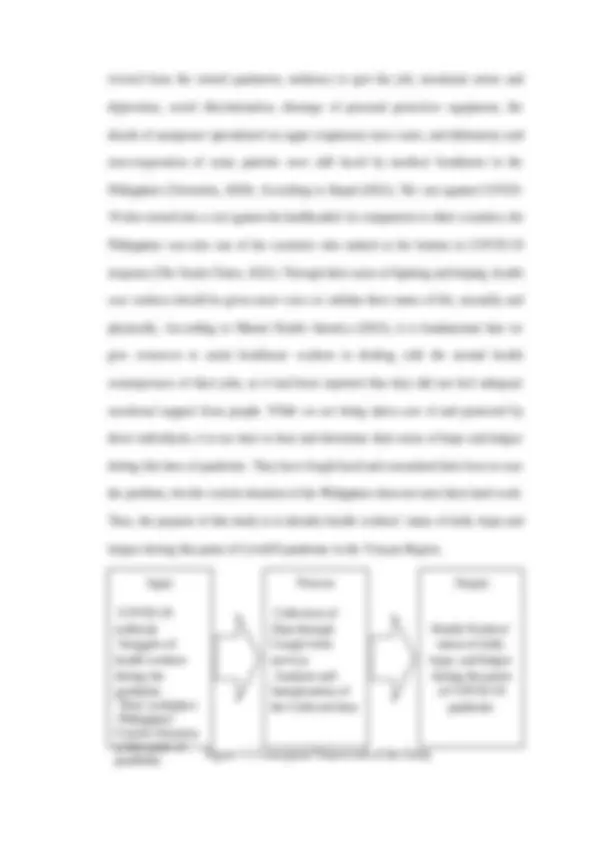
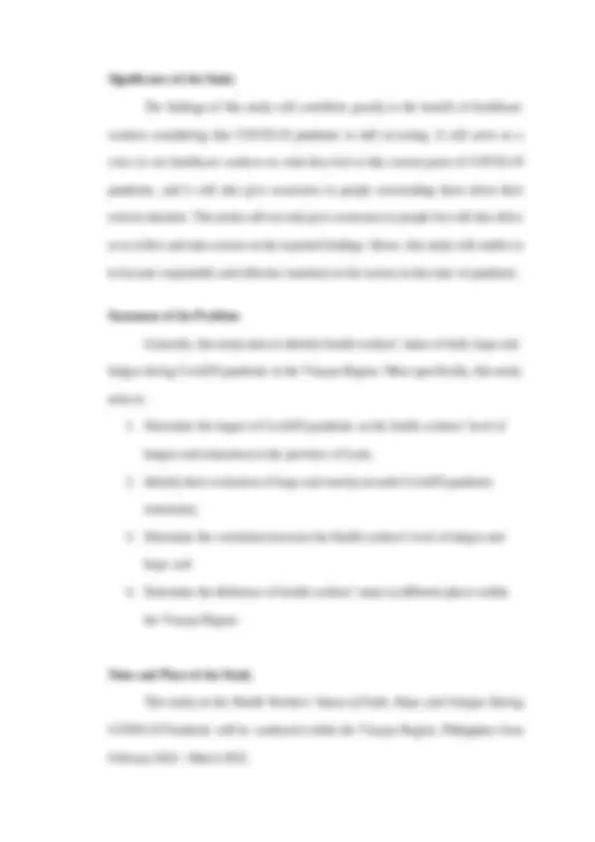
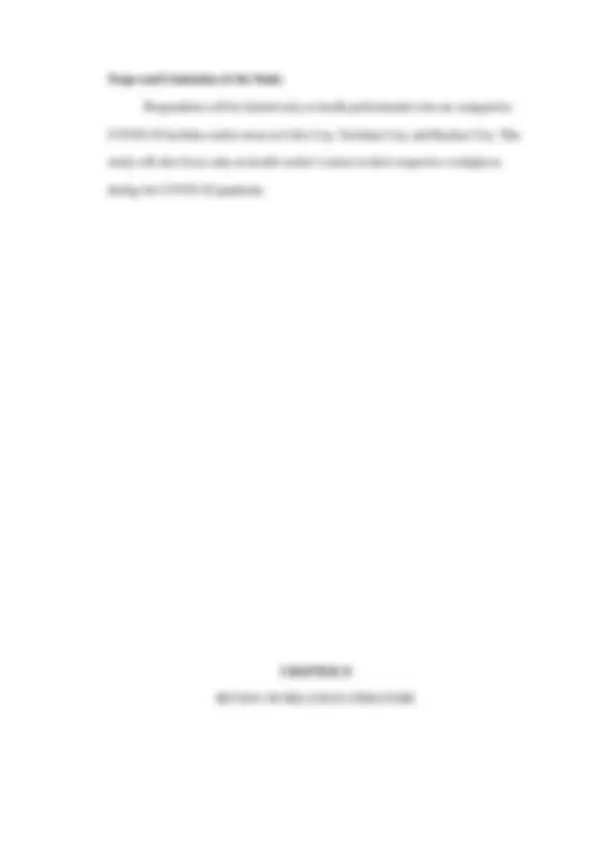
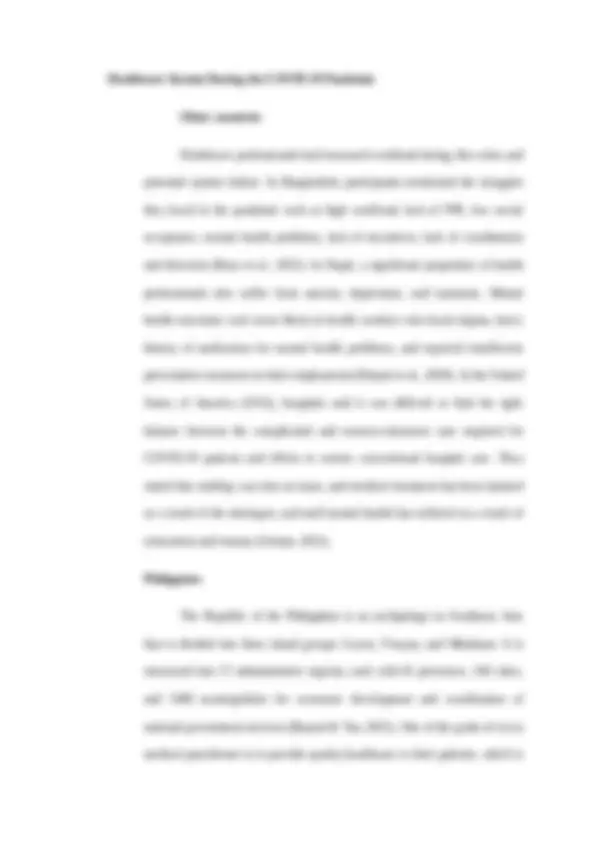
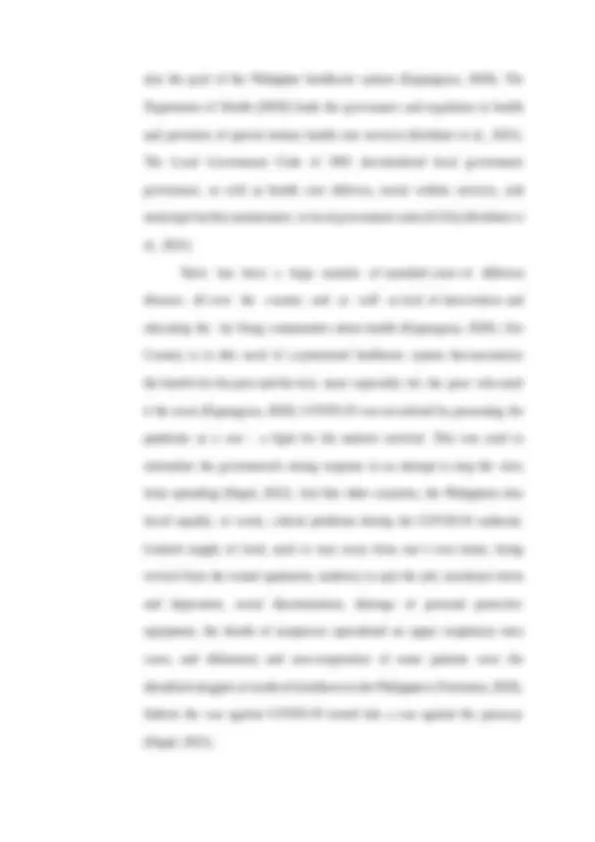
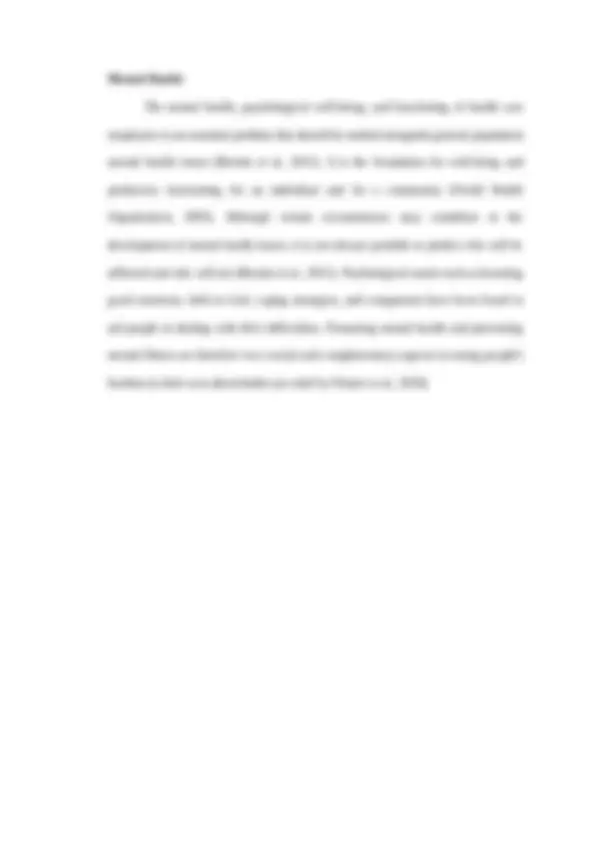
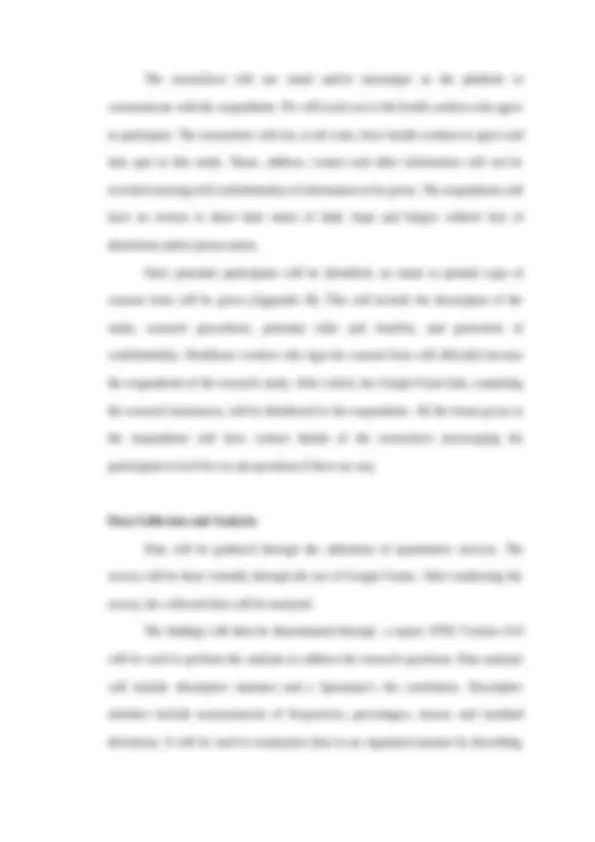
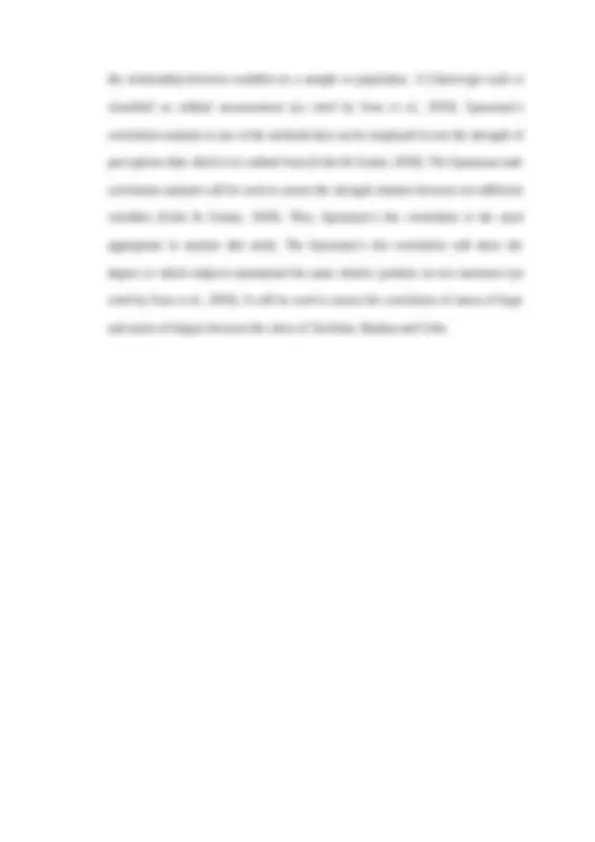
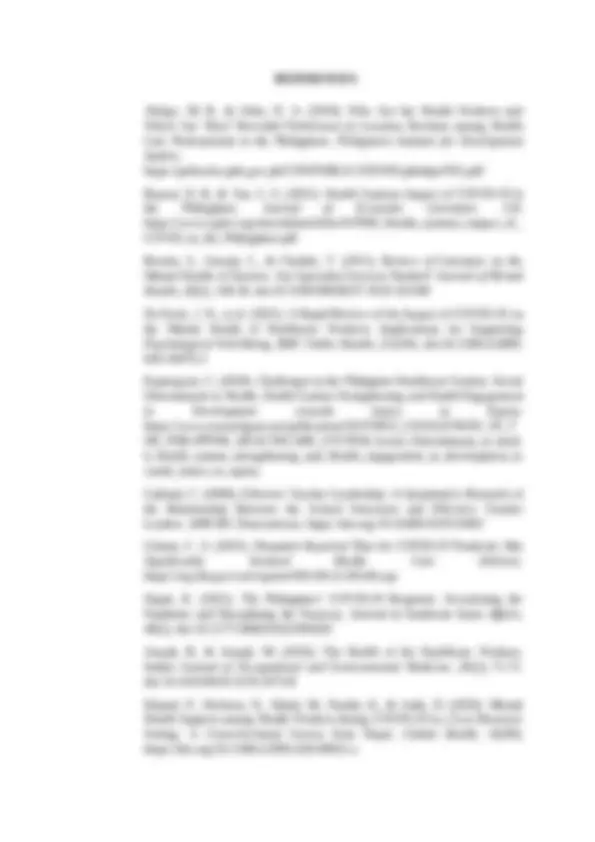
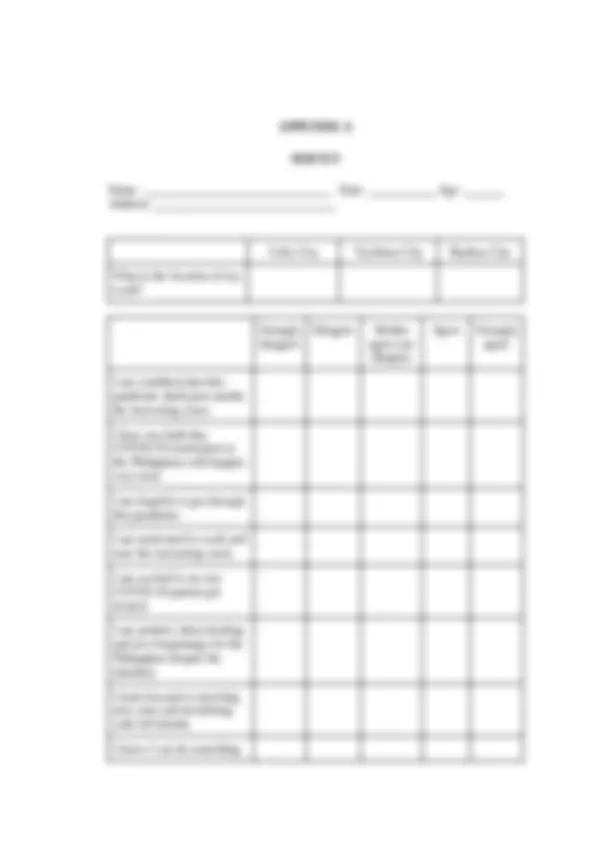
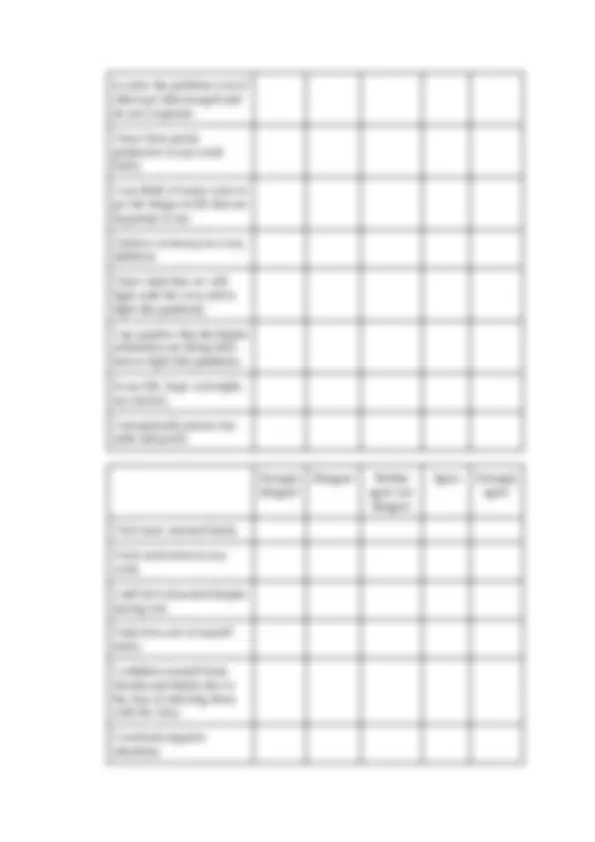
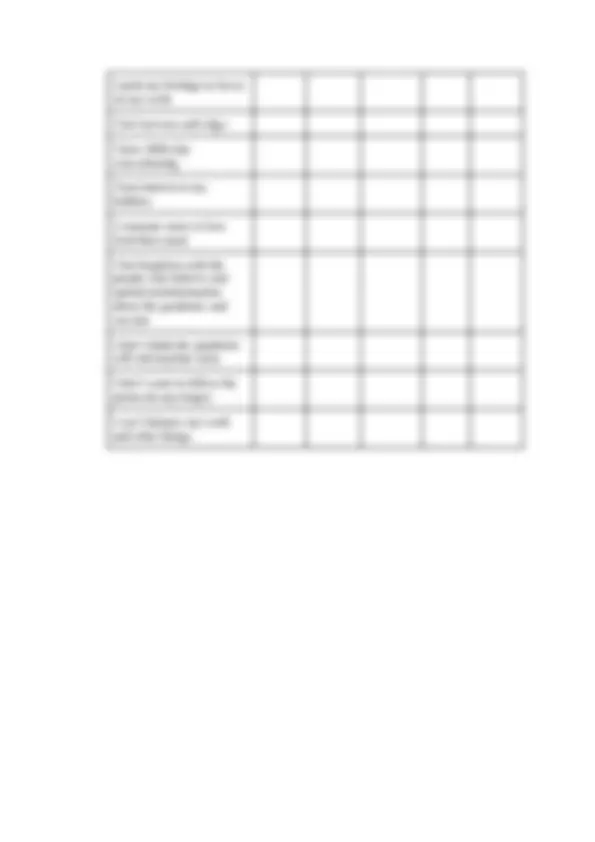
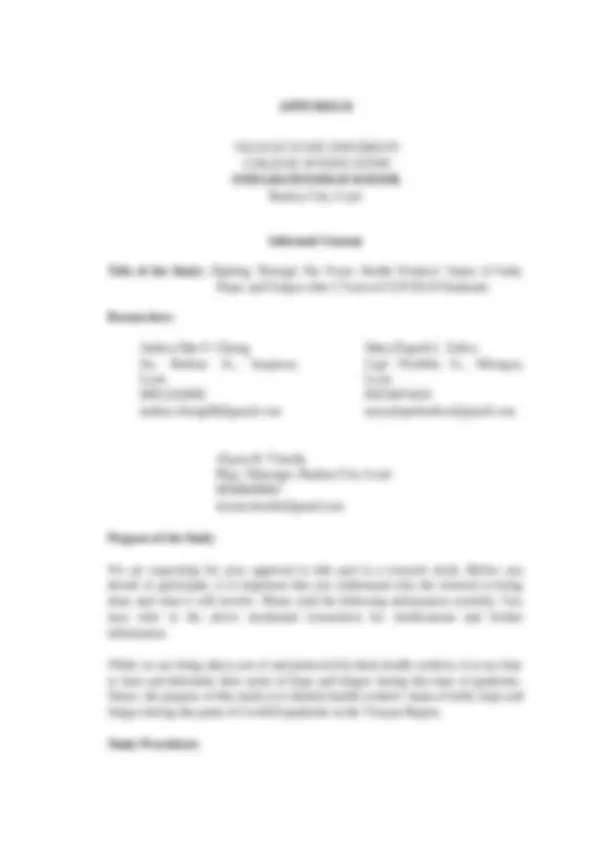
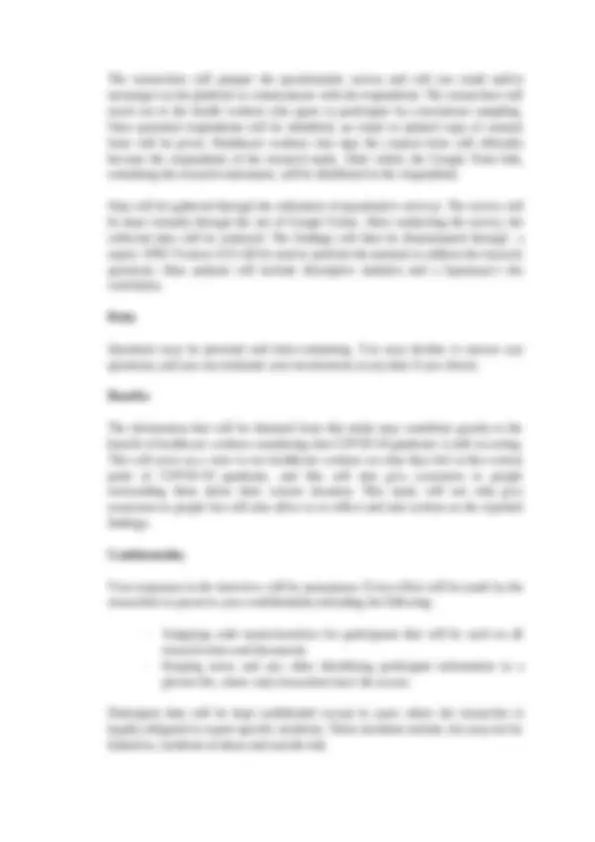
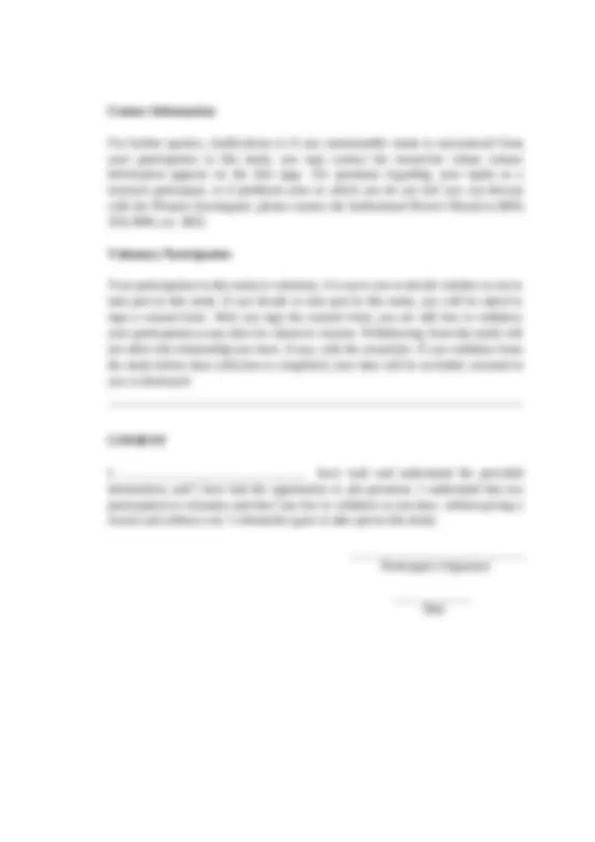


Study with the several resources on Docsity

Earn points by helping other students or get them with a premium plan


Prepare for your exams
Study with the several resources on Docsity

Earn points to download
Earn points by helping other students or get them with a premium plan
Community
Ask the community for help and clear up your study doubts
Discover the best universities in your country according to Docsity users
Free resources
Download our free guides on studying techniques, anxiety management strategies, and thesis advice from Docsity tutors
Group 11, Research Proposal.docx
Typology: Summaries
1 / 23

This page cannot be seen from the preview
Don't miss anything!
















A Research Proposal VISAYAS STATE UNIVERSITY INTEGRATED HIGH SCHOOL COLLEGE OF EDUCATION VISAYAS STATE UNIVERSITY ViSCA, Baybay City, Leyte ANDREA MAE P. CHIONG ALYZZA B. VITUALLA MARY ELSPETH L. ZAFICO SENIOR HIGH SCHOOL 12 STEM-B December 2021
Nature and Importance of the Study Novel coronavirus, known as COVID-19, was first recognized at the end of December 2019 in Wuhan, China. It spread quickly, resulting in an epidemic throughout China, followed by pandemic, with an increasing number of cases in various countries all over the world (Ozdemir, 2020). As a result, rapid public health measures, such as intensive surveillance, epidemiological investigation, and market closure, have been implemented by health authorities (as cited by Torales et al., 2020). Moreover, the long-term impact of COVID-19 on hospital utilization is currently observed in the Philippines (Bayani & Tan, 2021). This being the case, health authorities and professionals have been bombarded with responsibilities related to COVID-19 alongside their usual work routine. Health care workers (HCWs) are those that provide care and services to the sick and injured, either directly as a doctor or nurse or indirectly as an aide, helper, laboratory technician, or even a medical waste handler (Joseph B & Joseph M, 2016). In this time of health crisis, they play the most significant role to fight and ease the increasing covid-19 cases. Because of their commitment to contain the disease, they are particularly wasted during this pandemic. They encountered high workload, lack of PPE, low social acceptance, mental health problems, lack of incentives, lack of coordination and direction (Razu et al., 2021). In the Philippines, COVID-19 was securitized by presenting the pandemic as a war – a fight for the nation's survival. This was used to rationalize the government's strong response in an attempt to stop the virus from spreading (Hapal, 2021). However, limited supply of food, need to stay away from one’s own home, being
Significance of the Study The findings of this study will contribute greatly to the benefit of healthcare workers considering that COVID-19 pandemic is still occurring. It will serve as a voice to our healthcare workers on what they feel at this current point of COVID- pandemic, and it will also give awareness to people surrounding them about their current situation. This study will not only give awareness to people but will also allow us to reflect and take actions on the reported findings. Hence, this study will enable us to become responsible and reflective members in the society in this time of pandemic. Statement of the Problem Generally, this study aims to identify health workers’ status of faith, hope and fatigue during Covid19 pandemic in the Visayas Region. More specifically, this study aims to:
Scope and Limitation of the Study Respondents will be limited only to health professionals who are assigned in COVID-19 facilities and/or areas in Cebu City, Tacloban City, and Baybay City. This study will also focus only on health worker’s status in their respective workplaces during the COVID-19 pandemic. CHAPTER II REVIEW OF RELATED LITERATURE
constantly exposed to a complex variety of health and safety hazards in the course of their work (Joseph B & Joseph M, 2016). HCWs had significantly higher levels of MH risk in comparison to non-medical HCWs (De Kock et al., 2021). HCWs are in need of protection from these workplace hazards just as much as any other category of workers (Joseph B & Joseph M, 2016). HCWs play an important role in the COVID-19 pandemic response (De Kock et al., 2021). Healthcare professionals are particularly vulnerable during this pandemic owing to their commitment to contain the disease (Razu et al., 2021). While it has been shown that HCWs have higher resilience scores than the general population, they face unique workplace demands and are at a higher risk of depression, burnout, and suicide in their daily lives outside of crises (Smallwood et al., 2021). There are a number of COVID-19 cases and deaths for HCWs all over the world (Razu et al., 2021). It is critical to ensure the safety of HCWs not only to ensure continuous patient care but also to ensure they do not spread the virus, so infection rates in these groups should be evaluated (Sabetian et al., 2021). They were also bound to maintain physical distance from their family members to reduce the risk of contagion, which results in further psychological distress (Razu et al., 2021). Increased direct exposure to COVID-19 patients increased the mental health risks of HCWs (De Kock et al., 2021). Front line HCWs are at risk of significant psychological distress as a direct result of the COVID-19 pandemic (De Kock et al., 2021).
Healthcare System During the COVID-19 Pandemic Other countries Healthcare professionals had increased workload during this crisis and potential system failure. In Bangladesh, participants mentioned the struggles they faced in the pandemic such as high workload, lack of PPE, low social acceptance, mental health problems, lack of incentives, lack of coordination and direction (Razu et al., 2021). In Nepal, a significant proportion of health professionals also suffer from anxiety, depression, and insomnia. Mental health outcomes were more likely in health workers who faced stigma, had a history of medication for mental health problems, and reported insufficient preventative measures in their employment (Khanal et al., 2020). In the United States of America (USA), hospitals said it was difficult to find the right balance between the complicated and resource-intensive care required for COVID-19 patients and efforts to restore conventional hospital care. They stated that staffing was also an issue, and medical treatment has been harmed as a result of the shortages, and staff mental health has suffered as a result of exhaustion and trauma (Grimm, 2021). Philippines The Republic of the Philippines is an archipelago in Southeast Asia that is divided into three island groups: Luzon, Visayas, and Mindanao. It is structured into 17 administrative regions, each with 81 provinces, 146 cities, and 1488 municipalities for economic development and coordination of national government services (Bayani & Tan, 2021). One of the goals of every medical practitioner is to provide quality healthcare to their patients, which is
Mental Health The mental health, psychological well-being, and functioning of health care employees is an essential problem that should be studied alongside general population mental health issues (Brooks et al., 2011). It is the foundation for well-being and productive functioning for an individual and for a community (World Health Organization, 2005). Although certain circumstances may contribute to the development of mental health issues, it is not always possible to predict who will be afflicted and who will not (Brooks et al., 2011). Psychological assets such as boosting good emotions, faith in God, coping strategies, and compassion have been found to aid people in dealing with life's difficulties. Promoting mental health and preventing mental illness are therefore two crucial and complementary aspects in easing people's burdens in their own silent battles (as cited by Winzer et al., 2018).
Settings and Respondents This study will be conducted within the Visayas Region, Philippines. A number of sixty (60) respondents will be surveyed through the use of Google Forms. Respondents will be picked from hospitals of Cebu City, Baybay City and Tacloban City with twenty (20) respondents from each. Convenience sampling will be adopted to determine the respondents. Convenience sampling will be used because of the short availability of health workers due to their busy schedules. The researchers will get the data from a conveniently available pool of health workers. The respondents that will participate are only limited to health professionals who are currently assigned in COVID-19 facilities and/or areas. Research Design A quantitative research approach will be used as it is the most appropriate in satisfying the objectives of this study. Quantitative research is generally based on positivism, which holds that reality is observable and measurable (Galland, 2008). As there will be 60 respondents, quantitative research is more appropriate because it allows the researcher to collect data from multiple sources that could be meaningful to a broad range of practitioners within the field (Galland, 2008). More specifically, survey research design will be utilized in this study. Survey research design will allow the researchers to determine the health workers' status of faith, hope, and fatigue during the current point of COVID-19 pandemic. Hence, it is the most suitable and relevant research design for this study.
The researchers will use email and/or messenger as the platform to communicate with the respondents. We will reach out to the health workers who agree to participate. The researchers will not, at all costs, force health workers to agree and take part in this study. Name, address, contact and other information will not be revealed ensuring full confidentiality of information to be given. The respondents will have an avenue to share their status of faith, hope and fatigue without fear of distortions and/or prosecutions. Once potential participants will be identified, an email or printed copy of consent form will be given (Appendix B). This will include the description of the study, research procedures, potential risks and benefits, and protection of confidentiality. Healthcare workers who sign the consent form will officially become the respondents of the research study. After which, the Google Form link, containing the research instrument, will be distributed to the respondents. All the forms given to the respondents will have contact details of the researchers encouraging the participants to feel free to ask questions if there are any. Data Collection and Analysis Data will be gathered through the utilization of quantitative surveys. The survey will be done virtually through the use of Google Forms. After conducting the survey, the collected data will be analyzed. The findings will then be disseminated through a report. SPSS Version 14. will be used to perform the analysis to address the research questions. Data analysis will include descriptive statistics and a Spearman’s rho correlation. Descriptive statistics include measurements of frequencies, percentages, means, and standard deviations. It will be used to summarize data in an organized manner by describing
the relationship between variables in a sample or population. A Likert-type scale is classified as ordinal measurement (as cited by Sum et al., 2010). Spearman’s correlation analysis is one of the methods that can be employed to test the strength of perceptions data which is in ordinal form (Lobo & Guntur, 2018). The Spearman rank correlation analysis will be used to assess the strength relation between two different variables (Lobo & Guntur, 2018). Thus, Spearman’s rho correlation is the most appropriate to analyze this study. The Spearman’s rho correlation will show the degree to which subjects maintained the same relative position on two measures (as cited by Sum et al., 2010). It will be used to assess the correlation of status of hope and status of fatigue between the cities of Tacloban, Baybay and Cebu.
Lobo, M., & Guntur, R.D. (2018). Spearman’s rank correlation analysis on public perception toward health partnership projects between Indonesia and Australia in East Nusa Tenggara Province. Journal of Physics: Conference Series. doi:10.1088/1742-6596/1116/2/ Mental Health America (2021). The Mental Health of Healthcare Workers in COVID-19.https://mhanational.org/mental-health-healthcare-workers-covid- 19 Ozdemir, O. (2020). Coronavirus Disease 2019 (COVID-19): Diagnosis and Management. Erciyes Med Journal, 42 (3), 242-7. doi:10.14744/etd.2020. Ponto, J. (2015). Understanding and Evaluating Survey Research. Journal of the Advanced Practitioner in Oncology, 6 (2), 168-171. https://www.ncbi.nlm.nih.gov/pmc/articles/PMC4601897/ Razu, S. R., et al. (2021). Challenges Faced by Healthcare Professionals During the COVID-19 Pandemic: A Qualitative Inquiry From Bangladesh. Journal of the Frontiers in Public Health, 9. doi:10.3389/fpubh.2021. Sabetian, G., et al. (2021). COVID-19 Infection among Healthcare Workers: A Cross-Sectional Study in Southwest Iran. Virology Journal, 18 (58). doi:10.1186/s12985-021-01532- Showkat, N., & Parveen, H. (2017). Quantitative Methods: Survey. E-PG Patshala. https://www.researchgate.net/publication/318959206_Quantitative_Methods_ Survey Smallwood, N., et al. (2020). Coping Strategies Adopted by Australian Frontline Health Workers to Address Psychological Distress during the COVID-19 Pandemic. Elsevier Journal, 72 , 124-130. doi:10.1016/j.genhoppsych.2021.08. Sum, V., McCaskey, S. J., & Kyeyune, C. (2010). A Survey Research of Satisfaction Levels of Graduate Students Enrolled in a Nationally Ranked Top-10 Program at a Mid-Western University. Research in Higher Education Journal, 7. https://www.semanticscholar.org/paper/A-survey-research-of- satisfaction-levels-of-in-a-at-Sum-McCaskey/ e201a64b4cbc4f31918df513c7581dfeb3cb8cba Straitstimes (2021, September 29). T he Philippines Fell to Last Place in Covid-19 Ranking of Best and Worst Places to be in Pandemic.. https://www.straitstimes.com/asia/se-asia/the-philippines-just-became-the- worst-place-to-be-in-covid-19-pandemic Torales, J., O'Higgins, M., Castaldelli-Maia, J. M., & Ventriglio, A. (2020). The Outbreak of COVID-19 Coronavirus. International Journal of Social Psychiatry 2020, 66 (4), 317–320. doi:10.1177/
Torentira, M. J. (2020). The Medical Frontliners in a Designated COVID- Hospital in the Philippines. International Journal of Psychosocial Rehabilitation, 24 (7), 10084-10089. https://www.researchgate.net/publication/344125027_CARING_AMIDST_T HE_PANDEMIC_STRUGGLES_OF_THE_MEDICAL_FRONTLINERS_IN _A_DESIGNATED_COVID-19_HOSPITAL_IN_THE_PHILIPPINES Uy, J., Van, V. T., Ulep, V. G., Bayani, D. B., & Walker, D. (2021). The Impact of COVID-19 on Hospital Admissions for Twelve High-Burden Diseases and Five Common Procedures in the Philippines: A National Health Insurance Database Study 2019-2020. Elsevier. DOI:https://doi.org/10.1016/j.lanwpc.2021. Wiersinga, W. J., Rhodes, A., Cheng, A. C., & et.al. (2020). Pathophysiology, Transmission, Diagnosis, and Treatment of Coronavirus Disease 2019 (COVID-19) A Review. Journal of the American Medical Association, 324 (8), 782-793. doi:10.1001/jama.2020. Winzer, R., Lindberg, L., Guldbrandsson, K., & Sidorchuk, A. (2018). Effects of Mental Health Interventions for Students in Higher Education are Sustainable over Time: A Systematic Review and Meta-Analysis of Randomized Controlled Trials. PeerJ, 6 , e4598. doi:10.7717/peerj. World Health Organization (2004). Promoting Mental Health: Concepts, Emerging Evidence, Practice. https://www.who.int/mental_health/evidence/MH_Promotion_Book.pdf
to solve the problem even if others get discouraged and do not cooperate. I have been pretty productive in my work lately. I can think of many ways to get the things in life that are important to me. I believe in beauty in every darkness. I have faith that we will fight until the very end to fight this pandemic. I am positive that the higher authorities are doing their best to fight this pandemic. In my life, hope outweighs my anxiety. I energetically pursue my tasks and goals. Strongly disagree Disagree Neither agree nor disagree Agree Strongly agree I feel more stressed lately. I lack motivation in my work. I still feel exhausted despite having rest. I take less care of myself lately. I withdraw myself from friends and family due to the fear of infecting them with the virus. I overlook negative situations.
I push my feelings to focus on my work. I feel nervous and edgy. I have difficulty concentrating. I lost interest in my hobbies. I consume more or less food than usual. I feel hopeless with the people who believe and spread misinformation about the pandemic and vaccine. I don’t think the pandemic will end anytime soon. I don’t want to follow the protocols any longer. I can’t balance my work and other things.